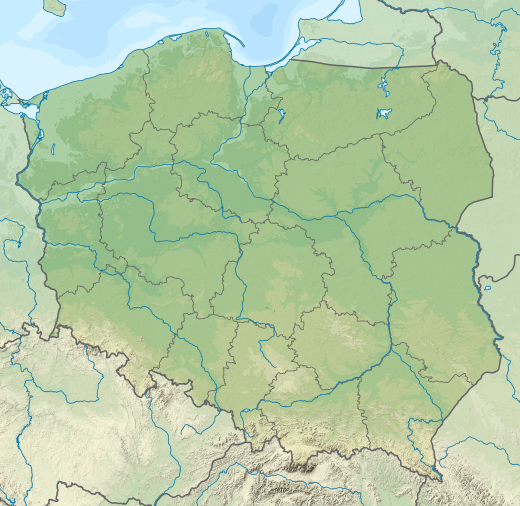1st Legions Infantry Division (Poland)
| 1st Legions Infantry Division | |
|---|---|
| Commanders | |
| Current commander | Brig. General Norbert Iwanowski |
| Notable commanders | Edward Rydz-Śmigły, Wincenty Kowalski |
| Insignia | |
| Unit abbreviation | 1 DPLeg |
| Parent Unit | Wyszków |
History
The 1st Legions Infantry Division tracks its origins to the 1919 establishment of the Polish state and was disbanded in 1944. After a 70-years long hyatus, the Division has been revived in the wake of the 2020s Polish rearmament.
1919-1944
As one of the most experienced and best equipped Polish divisions, it fought in many of the most notable battles of the
After that the division was moved to the rear and took part in shielding the border with
Before the outbreak of
From there, General Wincenty Kowalski planned a counter-assault of his division. In what became known as the
Order Of Battle
- Polish 1st Legions Infantry Regiment – Col. Kazimierz Burczak
- Polish 5th Legions Infantry Regiment – Lt.Col. Kazimierz Bąbiński
- Polish 6th Legions Infantry Regiment – Col. Stanisław Engel
- Polish 1st Legions Light Artillery Regiment – Lt. Col. Mieczysław Podlewski
- 1st Heavy Artillery Detachment – Maj. Władysław Świderski
- 1st Battalion of Engineers – Capt. Tadeusz Wejtko
- 1st Motorized AA Battery – 1st Lieut. Stefan Osostowicz
- Telephone company – Capt. Mika (?)
- Organic cavalry squadron – Maj. Bronisław Kulik
- 31st company of taczanka HMG– 1st Lieut. Stanisław Kasprzyk
- 31st Bicycle company – 1st Lieut. Jerzy Niemcewicz
- taborsand services
2022 - present
As a reaction to the Russian Invasion of Ukraine of 2022, the Polish
The headquarters of the revived 1DPLeg are in Ciechanów[2]
Mission
The 1st Legions Infantry Division is tasked to complement the defence of the Belarus–Poland border alongside the 16th Mechanised Division and the 18th Infantry Division.[3][4] Polish Defence Minister Mariusz Błaszczak stated that the formation is to "saturate" eastern Poland.[5]
As an organised military formation, the 1st Legions Infantry Division is also tasked to support the Department for Civil Protection and Crisis Management in case of emergency.[3]
Organisation 2024
The 1st Legions Infantry Division is to include a total of four Mechanised Brigades. Each of the Division's four Mechanised Brigades comprises four Mechanised Battalions and one Artillery Battalion.[6] The division will be the largest Polish formation and equipped with Polish and South Korean equipment. As of 2023/24 the 1st Legions Infantry Division consists of the following units:[7][8][9]
- 1st Legions Infantry Division "Józef Piłsudski", in Ciechanów
- 1st Command Battalion, in Ciechanów
- 1st Legions Armoured Brigade, in Czerwony Bór
- Command Battalion, in Czerwony Bór
- 1st Legions Tank Battalion, in Czerwony Bór
- 2nd Legions Tank Battalion, in Siemiatycze-Czartajew
- 2nd Legions Mechanised Brigade, in Brodnica
- Command Battalion, in Brodnica
- 1st Legions Mechanised Battalion, in Brodnica
- 3rd Legions Mechanised Brigade, in Ślubowo
- Command Battalion, in Ślubowo
- 1st Legions Mechanised Battalion, in Ślubowo
- 1st Legions Motorised Brigade, in Kolno
- Command Battalion, in Kolno
- 1st Legions Motorised Battalion, in Kolno
- 2nd Legions Motorised Battalion, in Grajewo
- 1st Legions Artillery Brigade, in Iława
- Command Battery, in Iława
- 1st Legions Anti-Tank Regiment, in Wielbark (forming)
- Command Company, in Wielbark
- 1st Legions Anti-Aircraft Regiment, in Ostrołęka
- Command Battery, in Ostrołęka
- 1st Legions Anti-Aircraft Squadron, in Ostrołęka
- 3rd Legions Sapper Regiment, in Chełmno
- Command Company, in Chełmno
- Legions Sapper Battalion, in Chełmno
- 1st Legions Logistics Regiment (forming)
- Command Company
- 1st Legions Reconnaissance Battalion, in Białystok
- 1st Legions Signal Battalion, in Ciechanów
- 1st Legions Chemical Battalion, in Brodnica
- 1st Division Training Center, in Czerwony Bór
- 2nd Division Training Center, in Ślubowo
Equipment
The 1st Legions Infantry Division does not deploy Soviet equipment.[4] The Mechanized Brigades are equipped with K2 Black Panther and M1A2 Abrams SEP V3 main battle tanks; the artillery units are equipped with K9 Thunder and AHS Krab howitzers.[6]
The co-presence of M1 Abrams and K2 Black Panther main battle tanks is a departure from the equipment of both the 16th Mechanized Division, which relies on Korean tanks, and the 18th Mechanized Division, which is equipped with M1 Abrams.[10]
The formation will also have the Gladius unmanned aerial reconnaissance and strike systems.[6]
See also
- Polish army order of battle in 1939
- Polish contribution to World War II
- List of Polish divisions in World War II
Bibliography
- Seidner, Stanley S. Marshal Edward Śmigły-Rydz Rydz and the Defense of Poland, New York, 1978.
- Lech Wyszczelski: Wojsko Polskie w latach 1918-1921. Warszawa: Wydawnictwo Neriton, 2006
- Zdzisław Jagiełło: Piechota Wojska Polskiego 1918-1939. Warszawa: Bellona, 2007
Notes
- ^ PAWEŁ PIOTR WIECZORKIEWICZ, WRZESIEŃ 1939 - PRÓBA NOWEGO SPOJRZENIA
- ^ "1. Dywizja Piechoty Legionów im. Marszałka Józefa Piłsudskiego".
- ^ a b Korsak, Ewa (3 April 2023). "Plan for Division". www.polska-zbrojna.pl. Retrieved 19 June 2023.
- ^ a b Graf, Jędrzej (26 April 2023). "Biggest Division of the Polish Army with Korean Equipment. General Iwanowski: All As Per Schedules and Budget". defence24.com. Retrieved 19 June 2023.
- ^ "Poland creates new army division on eastern border - English Section - polskieradio.pl". polskieradio.pl (in Polish). Polskie Radio. 9 January 2023. Retrieved 24 June 2023.
- ^ a b c Bisht, Inder Singh (12 January 2023). "Poland Raises New Infantry Division Along Belarus Border". The Defense Post. Retrieved 19 June 2023.
- ^ Graf, Jędrzej. "Biggest Division of the Polish Army with Korean Equipment. General Iwanowski: All as per schedules and budget". defence24. Retrieved 7 September 2023.
- ^ "Poland creates new army division on eastern border". Polskie Radio - English section. Retrieved 7 September 2023.
- ^ "Plan for Division". Polska Zbrojna. Retrieved 7 September 2023.
- ^ Ciślak, Jarosław (11 January 2023). "Poland Establishes Marshall Pilsudski Infantry Division". defence24.com (in Polish). Retrieved 26 June 2023.

